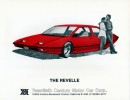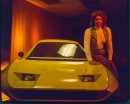The history of the Twentieth Century Motor Car Corporation, an American ‘automaker’ begun by Geraldine Elizabeth "Liz" Carmichael in 1974, became one of the strangest stories in American automotive history.
The vehicle at the center of the story was dubbed the Dale. It was a stylish two-seater, three-wheeled ‘automobile’ designed and built by Dale Clifft.
Powered by an air-cooled engine, the Dale was said to be capable of returning 70 mpg (3.4 L/100 km) of fuel economy and at a relatively reasonable $2,000 each - that amount was equivalent to approximately $10,000 in 2020 USD - made it an intriguing offering during the mid-1970s fuel crisis facing America at the time.
But the company would be mired in controversy and accusations of fraud when Carmichael split with investors' money.
Dale Clifft built the car’s frame from tubing and a Honda Super Hawk motorcycle subframe welded into the metal exoskeleton.
When she began pitching the vehicle, Carmichael told the Chicago Sun-Times at the time that her plan was to “take on General Motors or any other car manufacturer for that matter."
Carmichael claimed to have millions of dollars in backing "from private parties" and touted a 150,000 sq ft corporate office in Encino, California, as the location of her dream. The prototypes were constructed in Canoga Park, CA. She also claimed that the company would use a former aircraft hangar in Burbank as an assembly plant. She added that the company already had upwards of 100 employees.
Marketed as a high-tech, lightweight and safer alternative to any car on the market at the time, Carmichael was promising a sea change in how cars were designed and built.
"By eliminating a wheel in the rear, we saved 300 pounds and knocked more than $300 from the car's price,” Dale said.
According to Carmichael, the car's lightweight did not adversely affect the Dale's stability or safety. In addition, a low center of gravity was contained inside a triangle formed by the arrangement of the three wheels. That configuration, Carmichael said, made the car impossible for it to tip over. And as for safety, Carmichael also claimed that she once drove her prototype into a wall at 30 mph (48 km/h) without injuring herself or causing any structural damage to the car.
As for power, Carmichael said the Dale was built with a heavily modified BMW two-cylinder motorcycle engine capable of generating 40 hp (30 kW) that would let them reach a top speed of 85 mph (137 km/h).
She also said she fully expected the Dale would sell 88,000 vehicles during the first year of production and ramp up to 250,000 sales during the second year.
Carmichael debuted a non-functional model of the Dale at the 1975 Los Angeles Auto Show and promoted it on The Price Is Right, a popular television game show.
And to add to the pitch, Carmichael sweetened the deal by proposing a pair of other vehicles Dale. The ‘Revelle’ and the ‘Vanagen’ also featured the three-wheeled design and same BMW engine. But one of the vehicles was ever produced beyond three prototype vehicles, and just one of them was capable of rolling under its own power.
As rumors of a fraud surrounding Carmichael emerged, TV and newspaper investigations and an inquiry by the California Corporation Commission put heat on the promoter.
For his part, designer and builder Clifft told anyone who would listen that he believed in the project and said he was promised $3 million in royalties once the Dale went into production. Instead, Clifft ultimately received a paltry $1,001 and a later check for $2,000, which bounced.
As the accusations against Carmichael heated up, she went on the run, and the case was the subject of an episode of Unsolved Mysteries. Investigators found some additional and salacious details about the promoter and revealed that she had been assigned male at birth and was wanted on counterfeiting charges from the time before she transitioned. She was eventually found working under the alias Katherine Elizabeth Johnson at a flower shop in Texas. Carmichael appealed the fraud charges resulting from the Dale incidents for a number of years before going missing for nearly a decade. She was captured just two weeks after her story was broadcast on Unsolved Mysteries.
An HBO four-part documentary, The Lady and the Dale, presented "stories about fraud, flight, FBI manhunts, transgender politics, selective prosecution, bias in the media, and corruption in the courts."
That documentary suggests that there were genuine attempts made to actually build the car and that just three genuine prototypes were believed to have been made, one of which was fully operational.
Carmichael died of cancer in 2004. Clifft, who was never proved to be a participant in the fraud, later formed The Dale Development Co. and was awarded several patents before his passing in 1981.
Now, one Dale resides in the collection of the Petersen Automotive Museum in Los Angeles, and the running prototype is owned by a private collector.
Powered by an air-cooled engine, the Dale was said to be capable of returning 70 mpg (3.4 L/100 km) of fuel economy and at a relatively reasonable $2,000 each - that amount was equivalent to approximately $10,000 in 2020 USD - made it an intriguing offering during the mid-1970s fuel crisis facing America at the time.
But the company would be mired in controversy and accusations of fraud when Carmichael split with investors' money.
When she began pitching the vehicle, Carmichael told the Chicago Sun-Times at the time that her plan was to “take on General Motors or any other car manufacturer for that matter."
Carmichael claimed to have millions of dollars in backing "from private parties" and touted a 150,000 sq ft corporate office in Encino, California, as the location of her dream. The prototypes were constructed in Canoga Park, CA. She also claimed that the company would use a former aircraft hangar in Burbank as an assembly plant. She added that the company already had upwards of 100 employees.
Marketed as a high-tech, lightweight and safer alternative to any car on the market at the time, Carmichael was promising a sea change in how cars were designed and built.
According to Carmichael, the car's lightweight did not adversely affect the Dale's stability or safety. In addition, a low center of gravity was contained inside a triangle formed by the arrangement of the three wheels. That configuration, Carmichael said, made the car impossible for it to tip over. And as for safety, Carmichael also claimed that she once drove her prototype into a wall at 30 mph (48 km/h) without injuring herself or causing any structural damage to the car.
As for power, Carmichael said the Dale was built with a heavily modified BMW two-cylinder motorcycle engine capable of generating 40 hp (30 kW) that would let them reach a top speed of 85 mph (137 km/h).
She also said she fully expected the Dale would sell 88,000 vehicles during the first year of production and ramp up to 250,000 sales during the second year.
Carmichael debuted a non-functional model of the Dale at the 1975 Los Angeles Auto Show and promoted it on The Price Is Right, a popular television game show.
As rumors of a fraud surrounding Carmichael emerged, TV and newspaper investigations and an inquiry by the California Corporation Commission put heat on the promoter.
For his part, designer and builder Clifft told anyone who would listen that he believed in the project and said he was promised $3 million in royalties once the Dale went into production. Instead, Clifft ultimately received a paltry $1,001 and a later check for $2,000, which bounced.
As the accusations against Carmichael heated up, she went on the run, and the case was the subject of an episode of Unsolved Mysteries. Investigators found some additional and salacious details about the promoter and revealed that she had been assigned male at birth and was wanted on counterfeiting charges from the time before she transitioned. She was eventually found working under the alias Katherine Elizabeth Johnson at a flower shop in Texas. Carmichael appealed the fraud charges resulting from the Dale incidents for a number of years before going missing for nearly a decade. She was captured just two weeks after her story was broadcast on Unsolved Mysteries.
That documentary suggests that there were genuine attempts made to actually build the car and that just three genuine prototypes were believed to have been made, one of which was fully operational.
Carmichael died of cancer in 2004. Clifft, who was never proved to be a participant in the fraud, later formed The Dale Development Co. and was awarded several patents before his passing in 1981.
Now, one Dale resides in the collection of the Petersen Automotive Museum in Los Angeles, and the running prototype is owned by a private collector.















